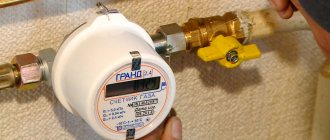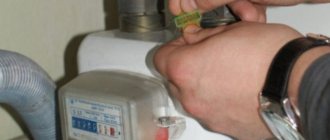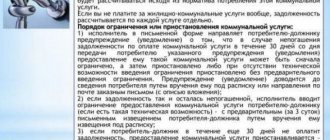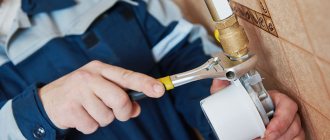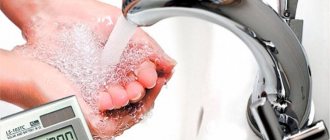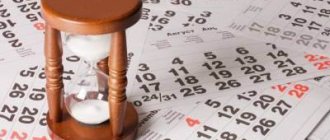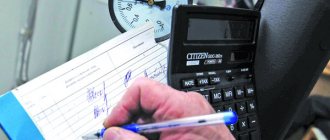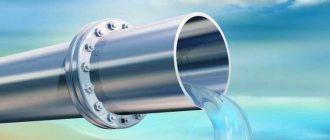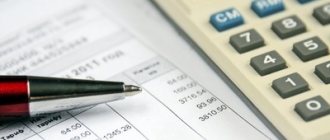Comparison of tariffs with and without a water meter
Owners of premises with a meter pay for utilities according to indications - in this case everything is quite simple.
Homeowners without metering devices will have to pay according to standards , so it is important for them to take into account Government Resolution No. 306 of 2006, which establishes the procedure for determining the rate of resource consumption per person.
In accordance with this document, the final decision is approved by local authorities. For example, in Moscow the consumption rate for cold water is 6.94 m3, hot water consumption is 4.75 m3, and in St. Petersburg it is 4.90 m3 and 3.48 m3, respectively.
Regardless of the availability of metering devices, it is important for property owners to know the established tariff, which is also approved at the regional level. The average value in Russia for 1 m3 of cold water is 30 rubles, hot – 100 rubles.
The installed meter simplifies the process of calculating the amount to be paid: it is enough to find the product of the device readings and the current tariff, taking into account the category of water supply.
In the absence of a device, the owner of the premises needs to:
- Find out the number of persons registered in a given residential area.
- Check the water standards set by local authorities for the current period.
- Find out tariff values.
- Take into account the increasing coefficient, which was introduced by Decree of the Government of the Russian Federation No. 344 of 2013. It applies to premises where a meter is not installed or is in a faulty condition. This indicator is 1.5.
For a more complete understanding, it is worth looking at a specific example of calculating water charges without a meter for a family of three registered in St. Petersburg:
- the consumption rate of cold water per person is 4.9 m3;
- tariff for 1 m3 of cold water – 30.8 rubles;
- DHW consumption rate per person – 3.49 m3;
- tariff for 1 m3 of hot water supply is 106.5 rubles.
The amount payable for water supply is determined as follows:
- For cold water 679.1 rubles = 3*4.9*30.8*1.5.
- For hot water 1,672.6 rubles = 3 * 3.49 * 106.5 * 1.5.
- Total 2351.7 rubles = 1672.6 + 679.1.
The real average monthly water consumption per person is: 2.92 m3 of cold water and 2.04 m3 of hot water. That is, the same family of three, after installing a metering device, will need to pay:
- For cold water 269.8 rubles = 3*2.92*30.8.
- For hot water 651.8 rubles = 3 * 2.04 * 106.5.
- Total 921.6 rubles = 269.8 + 651.8.
A family from St. Petersburg will have to pay almost 3 times less after installing a meter, which speaks in favor of having the necessary equipment.
How much will you have to pay for general house needs?
The receipt for utilities also contains the column “General house needs”, which the owners of apartment buildings are forced to pay for . This item includes water costs for cleaning premises, entrances, elevators, watering the club in the local area, etc.
How much you have to pay depends on the availability of a communal and individual metering device.
If devices are installed, payment is made as follows:
When calculating ODN, first of all, readings are taken - PU shows how much resources were consumed by the MKD during the reporting period.
For example, 2 thousand m3 is the amount of water that was used both for general household consumption and for individual consumption (by apartment owners).- The following summarizes the readings of the IPU, which were provided by the owners of the premises. For example, 1.8 thousand m3. To ensure the correctness of the flow balance, values for general and individual devices are taken at the same time.
- At the third stage, the volume of consumption is allocated for servicing common areas: 200 m3 = 2,000 – 1,800 (this much was spent on watering flower beds, washing entrances, etc.).
- The fourth step is the distribution of one tax credit to all residents. To do this, you need to determine the volume per 1 m2. Let’s say the total area of the apartment building is 7 thousand m2. Then the desired value will be: 0.038 m3 = 200/7,000.
- To obtain a calculation for a specific apartment, you need to multiply the identified volume by the area of the housing. For example, it is 50 m2: 1.9 m3 = 0.038*50.
Finally, payment is calculated taking into account regional tariffs. A family from St. Petersburg will have to pay: 58.5 rubles = 1.9 * 30.8. If there is no communal meter, the calculation is carried out according to established standards, taking into account the increasing coefficient, which implies an increase in the amount by 4-5 times.
Details
Payment for general house expenses
If you study the receipt for water services, it contains a column for paying expenses for General Household needs, which fall on the shoulders of homeowners. It includes expenses for water during cleaning of floors, elevators, and watering flower beds at the entrance. The total amount for payment consists of the values for general house expenses and the meter in the apartment.
In the absence of metering devices, payment is made as follows:
1. When calculating general house needs, they take into account the readings of metering devices, which show how much water was consumed by the apartment building for a certain time.
For example, the PU shows two thousand cubic meters, which means that this much water was spent by individual owners and for general household needs.
2.Then you should calculate the indicators of individual metering devices provided by the owners. For example, 1.8 thousand cubic meters.
Attention! In order for the readings to be correct, it is necessary to take the IPU and PU indicators at the same time.
3. It is necessary to highlight the amount of water that was required to care for the common areas: 2000-1800 = 200 cubic meters (for watering flower beds, washing the entrance).
4. ODN must be distributed to all apartments. You need to find out how much water is required per cubic meter. An example is given by an apartment building with a total area of 7 thousand square meters. We get 200: 7000 = 0.038 cubic meters.
5.The area of each apartment is multiplied by the resulting value. Example, given an apartment area of 50 square meters, then 0.038 x 50 = 1.9 cubic meters.
According to the established tariffs in the region (in St. Petersburg), a family will pay 1.9 x 30.8 = 58.5 rubles. If there is no common meter in the house, then the calculation will be carried out according to the established tariff, which must be multiplied by an increasing factor. This means that the amount will increase up to five times.
How much will you need to pay for installation and maintenance of meters?
To install a meter, you need to pay money. You need to find out how much you will have to spend on installing and maintaining the device:
1.first you need to buy a meter, which costs at least 800 rubles. For a higher quality product you will have to pay 2-3 thousand rubles.
Attention! You will have to set aside at least two thousand rubles to purchase meters, because separate devices are required for cold and hot water supply. The price of a hot water device is much higher.
2. to call a specialist to install the device, you will have to pay at least 1.5 thousand rubles. The price is affected by the place of residence and the complexity of the equipment for installation. You can install the device yourself, but without experience in plumbing, it is better to call a professional.
3.Metering devices are subject to verification every 6 years for cold water, 4 years for hot water. To do this, you also need to call a specialist so that he issues a certificate of work done and puts a mark in the technical passport of the device. For this you need to pay at least 500 rubles.
4. If the device’s service life has expired, it must be replaced. They also call a master; his services will cost at least a thousand rubles.
Low levels of water quality reduce the service life of devices, so they often have to be replaced more often (every seven to nine years) or devices need to be repaired. As a result, installing the cheapest meter for hot and cold water will cost 3.5 thousand rubles. If recalculated in cubic meters of water, it will be 113 cubic meters of cold water, and hot – 32 cubic meters (according to the standards of St. Petersburg).
Attention! The cost of installing the meter pays off in the first three to five months of operation of the device.
What cases require mandatory installation?
In all situations, it is better to install metering devices. The exception is the situation if the registration lists one resident, but in reality at least five live, and they consume a lot of water.
When is it even better to have a counter:
1. during absence from the apartment, payment for services will not be charged, not counting general house services. Without IPU, payment for water will be charged, even in the absence of family members in the apartment during this period.
2. if there is no meter, the owners pay for unused water, because the standards indicate too much water that it is impossible to spend.
3. The increase factor may increase.
Attention! How profitable it is to install a meter can be found out by calculating the difference in readings without a meter (from the last receipt) and with a meter.
Costs for purchase, installation, verification, replacement of the device
Installing a meter is not a free event. If the apartment owner decides to get a meter in order to pay less, he should initially evaluate the associated costs:
The cheapest equipment can be purchased for 800 rubles.
If a higher quality device is required, then it is recommended to pay attention to the IPU in the price range from 2 thousand to 3 thousand rubles. In any case, you need to set aside at least 2 thousand rubles for the purchase - for a meter for hot water supply and separately for hot water supply, whose price is justified higher.- For installation of the IPU, you will have to pay a specialist from 1.5 thousand rubles - the cost largely depends on the region, the selected equipment and complications in the installation. You can do the installation yourself, however, if you do not have the skills of a plumber, it is not recommended to resort to this method.
- According to the regulations, devices must be checked every 6 years for cold water supply, and 4 years for hot water supply. All this requires calling a competent specialist who will put the necessary marks in the technical passport. The service costs from 500 rubles.
- After the expiration of the service life, the device must be replaced. As with the initial installation, you need to hire a plumber. In this case, the work will cost from 1 thousand rubles.
Individual metering devices do not always withstand their entire service life due to the poor quality of pipelines and water in Russia. Therefore, the owner will have to purchase a new meter every 7-9 years or spend money on equipment repairs.
For the cheapest option, you will initially have to pay 3.5 thousand rubles . Which, in terms of cubic meters of water, is 113 m3 of cold or 32 m3 of hot (if we take the standards of St. Petersburg). Despite this, in practice, costs can be covered within 3-5 months of using the meter.
Is it profitable to install water meters?
First of all, meters are installed with the idea that you will now pay less for the water you use than those who pay based on average spending (those who do not have meters).
In all regions, the figure that indicates the accepted expenditure of liters of water used per resident is different. For example: one person spends 260 and 100 liters of cold and hot water, respectively. But to understand and calculate how many liters of water your family needs, let's look at some statistics.
- When you decide to take a bath, you will need 200 liters of water.
- A person needs 5 - 15 liters per day to wash their hands.
- Just by taking a shower, you will waste 25 - 40 liters of water.
- You may not have thought about it, but the toilet tank takes from 4 to 7 liters of cold water from you at a time
- A washing machine will require 30 - 90 liters for one wash
Of course, all the data given is relative, since we all cannot spend the same amount of water, but you can already roughly calculate the volume of water used for your family.
Of course, it is worth paying attention to many details. When the amount of water consumed is large enough, the meter will take into account every liter, but in the case where one or more people live, pensioners, for example, the meter will help save money due to minimal water use.
In what cases is it important to install?
Installing an individual metering device is relevant in almost every case. The exception is situations when one person is registered in the apartment, but 5 or more live. At the same time, they all actively use water.
In other circumstances, installation of the device is necessary:
When you go on vacation for a month, you won’t have to pay almost anything for water (except for one payment). If there is no IPU, accrual will occur even if no one was at home all this time- To spend the entire approved consumption standard, you need to splash around in the bathroom for days or not turn off the water at all. Therefore, in the absence of a device, the citizen pays for the unused resource.
- The multiplying factor may increase.
You can find out the benefit very simply by taking the latest readings from the receipt and calculating the difference between the situation with and without a meter.
You will find a lot of useful information about installing water meters here.
Is it necessary to install meters in 2019-2020?
Is it necessary to install water meters? It is described in No. 261-FZ “On energy saving and increasing energy efficiency,” which was adopted on December 23, 2009. He clearly explains that meters can be refused, and there are no penalties for their absence by law.
However, those who do not install meters pay for water with an increasing coefficient. (Resolution of the Government of the Russian Federation dated June 29, 2016 No. 603). In 2021, this increase factor is 1.5.
Consumers who have not installed a water meter pay according to the formula:
Payment = (number of people living in the apartment) X (consumption standard (in cubic liters) X (cost of a cubic liter) X 1.5.
Those who have proven that it is not technically possible to install a water meter in their apartment or house are exempt from the increasing coefficient.
For those who pay by meter, the formula is as follows:
Payment = (amount of water according to meters (in cubic liters) X (cost of a cubic liter)
So, it is not at all necessary to install meters in 2019-2020. However, your water bill will likely be quite high.
We must also take into account that management companies (hereinafter referred to as management companies) are directly interested in installing water meters. The Criminal Code is responsible for the implementation of the law in houses and apartments under their jurisdiction. Therefore, you are guaranteed to receive annoying calls from them.
To decide whether or not to install a water meter, you need to calculate the amount spent on the purchase of water meters, installation and monthly payments. Then compare with the amount of payment that the owner expects in 2021.
